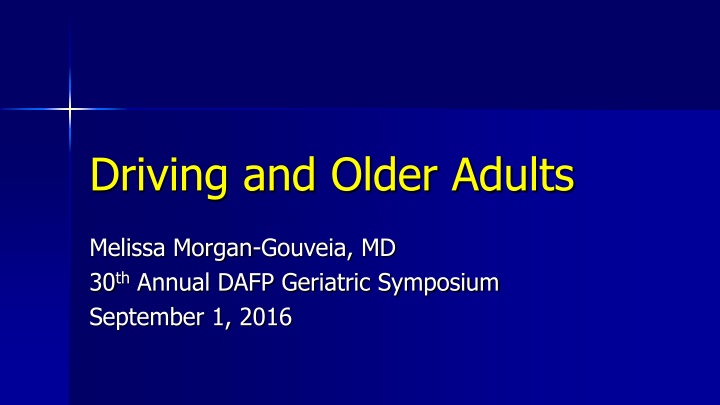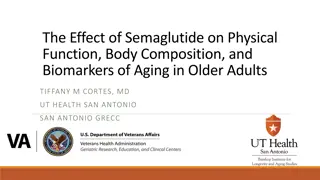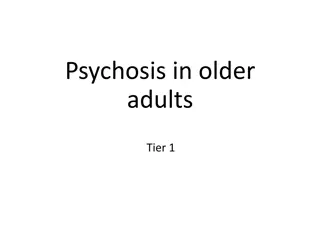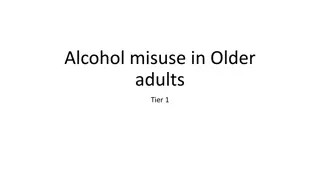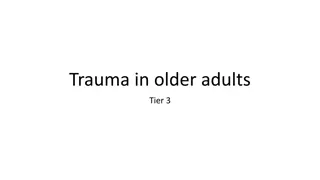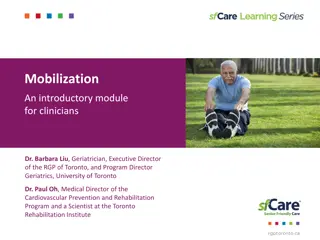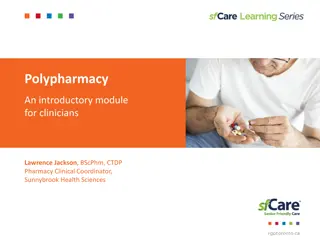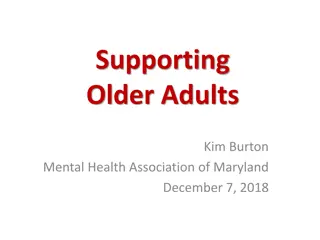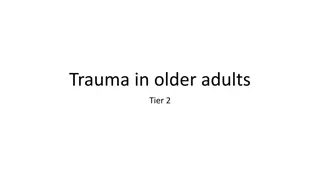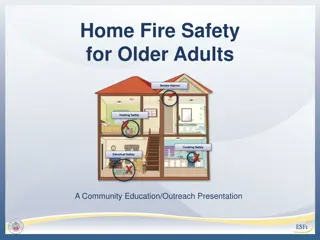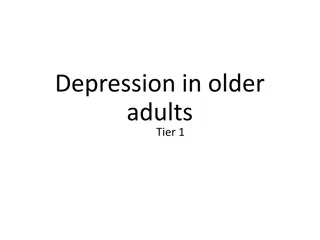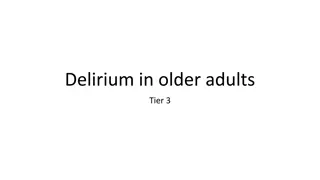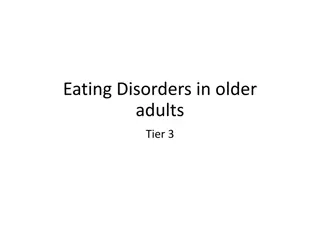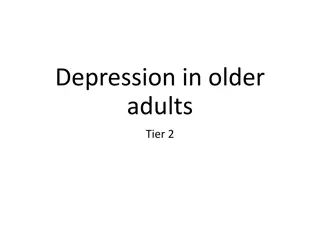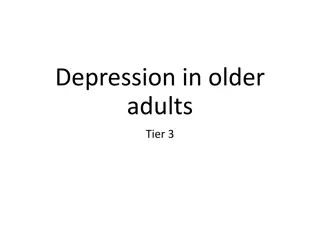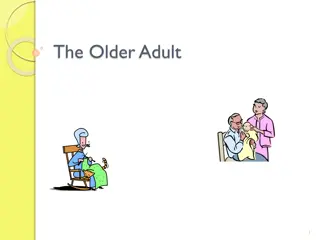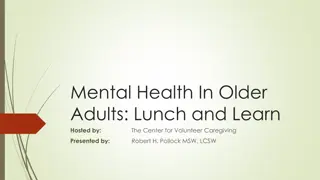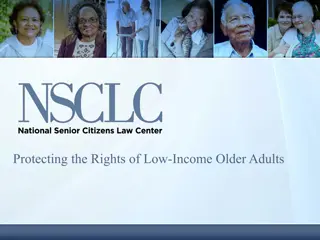Driving and Older Adults
Statistics related to older adults and driving, including crash rates and safety measures. Provides insights on evaluating driving ability and initiating conversations about safe driving practices with aging patients.
Download Presentation

Please find below an Image/Link to download the presentation.
The content on the website is provided AS IS for your information and personal use only. It may not be sold, licensed, or shared on other websites without obtaining consent from the author.If you encounter any issues during the download, it is possible that the publisher has removed the file from their server.
You are allowed to download the files provided on this website for personal or commercial use, subject to the condition that they are used lawfully. All files are the property of their respective owners.
The content on the website is provided AS IS for your information and personal use only. It may not be sold, licensed, or shared on other websites without obtaining consent from the author.
E N D
Presentation Transcript
Driving and Older Adults Melissa Morgan-Gouveia, MD 30thAnnual DAFP Geriatric Symposium September 1, 2016
Disclosures No financial disclosures
I am a current member of the ABIM Geriatric Medicine Specialty Board To protect the integrity of Board Certification, ABIM enforces strict confidentiality and ownership of exam content. As a member of the Geriatric Medicine Specialty Board, I agree to keep exam information confidential. As is true for any ABIM candidate who has taken an exam for Certification, I have signed the Pledge of Honesty in which I have agreed not to share ABIM exam questions with others. No exam questions will be disclosed in my presentation
Objectives Review statistics related to older adults and driving Review medical conditions and medications that can impair driving ability Describe methods of evaluating driving ability Discuss strategies for having conversations about driving with patients and their caregivers Provide resources for patients and caregivers
Driving and Older Adults The number of drivers age 70 and older is growing Licensed drivers 70 increased 38% between 1997 & 2014 Reflects both increase in population and drivers keeping licenses longer 24.4 million licensed drivers age 70 and older in 2014 Representing 79% of the population age 70 and 11% of drivers of all ages Older drivers involved in fewer fatal collisions than in the past 29% fewer people age 70 died in crashes in 2014 than 1997 Source: Insurance Institute for Highway Safety, http://www.iihs.org/iihs/topics/t/older-drivers/qanda
Crash Rates for Older Drivers Older drivers have low rates of police-reported crash involvements Fatal crash rates begin to increase at age 70 Per capita rate of passenger vehicle crash involvements by driver age, 2011. Source: www.iihs.org
Crash Rates Per Mile Traveled Crash rates and fatal crash rates per mile traveled start increasing at age 70 May be somewhat inflated based on more city driving (where crash rates are higher) and less highway driving (where rates are lower) Rate of passenger vehicle crash involvements per mile traveled by driver age, 2008. Source: www.iihs.org.
Fragility and Fatal Crash Rates Older adults have an increased risk of death in crashes Increased incidence of osteoporosis and fractures Increased atherosclerosis of aorta predisposing to rupture Drive older model cars Number of passenger vehicle driver deaths per 1,000 drivers involved in police-reported crashes by driver age, 2007-2011. Source: www.iihs.org.
Collisions and Older Drivers Older drivers are more likely to be involved in collisions at intersections Failure to yield the right of way is the most common error Inadequate surveillance Looking but not seeing > failing to look Affected by vision impairment, decreased range of head movement, ability to process multiple sources of information Misjudge length of gap between vehicles or another vehicle s speed
Driving Safety and Older Drivers Higher incidence of seat belt use 79% vs. 66% for adults aged 18-64 Drive when conditions are safer Avoid night driving, driving in ice and snow Lower incidence of impaired driving 8% of fatally injured passenger vehicle drivers 70 years and older in 2014 had blood alcohol concentrations 0.08%, compared with 20% for drivers ages 60-69 and 38% for drivers ages 16-59 http://www.cdc.gov/motorvehiclesafety/older_adult_drivers/ http://www.iihs.org/iihs/topics/t/older-drivers/fatalityfacts/olderpeople/2014
Importance of Driving Driving is essential for many older adults to remain independent and engaged in their community Transportation to employment or volunteer work Access to nutrition, medical care, social activities May be only means of transportation in some rural and suburban areas
Impact of Driving Cessation Loss of independence Decreased social integration Decreased out of home activities Increased anxiety and depression symptoms Increased risk of nursing home placement Chihuri, S, et al. Driving Cessation and Health Outcomes in Older Adults. J Am Geriatr Soc 64:332 341, 2016.
Prevention of Driving Disability Primary Prevention Assess older driver and intervene to prevent driving disability Secondary Prevention Address issues that have already caused loss of driving skills and attempt to restore those skills through treatment and rehabilitation Tertiary Prevention Identify when irreversible loss of driving skills has occurred and recommend alternatives to avoid harm when driving is no longer an option American Geriatrics Society & A. Pomidor, Ed. (2016)
How do you assess driving ability? A moment such as this was and is awkward. I dreaded conversations about driving. Driving safety wasn t something I could treat with a prescription or with how-to medical advice. It was a big, messy issue that sprawled beyond the confines of the office into the realm of public safety. Like most of my peers, I had little experience in assessing safe driving, whether for the elderly or for patients of any age. It wasn t covered in medical school or residency training. The only driving-related question we were trained to ask Do you wear a seat belt? was buried in a general office-visit checklist, somewhere between Have you ever injected drugs? and Do you have a gun in the house? None of my professors or mentors had ever told me that I might bear some responsibility for deciding whether a patient should be behind the wheel. Reisman, A. Surrendering the keys: A doctor tries to get an impaired elderly patient to stop driving. Health Affairs. 2011. 30:356-359.
Driving Assessment American Geriatrics Society & A. Pomidor, Ed. (2016, January). Clinician s guide to assessing and counseling older drivers, 3rd edition. (Report No. DOT HS 812 228). Washington, DC: National Highway Traffic Safety Administration. Available at: GeriatricsCareOnline.org or http://www.nhtsa.gov/Driving+Safe ty/Older+Drivers
Is my patient at risk for unsafe driving? Screen for red flags Older adult driver s or caregiver s concerns Recent adverse driving events or behaviors Medical conditions (acute and chronic) Medications that can affect driving ability Do not make assumptions about whether a person is driving Age alone is not a red flag for driving safety Goal of screening to optimize driving safety
Medical Conditions that Impair Driving Vision Impairments Cataracts Macular Degeneration Glaucoma Diabetic retinopathy Visual field cuts Low visual acuity Cardiovascular Unstable coronary syndromes Arrhythmias CHF Valvular disease Respiratory Obstructive sleep apnea COPD
Medical Conditions that Impair Driving Neurologic Seizures Dementia Multiple sclerosis Parkinson s disease Stroke Peripheral neuropathy Traumatic brain injury Spinal cord injury Psychiatric Anxiety and depression Psychosis Alcohol and substance abuse Metabolic Diabetes Musculoskeletal Osteoarthritis
Medications that Impair Driving Ability Anticholinergics Anticonvulsants Antidepressants Antihistamines Antihypertensives Antiparkinsonians Antipsychotics Benzodiazepines and other sedative/hypnotics Muscle relaxants Narcotic analgesics Stimulants *Providers should always counsel patients of any age about possible effects of medications on driving and document this counseling.
Dementia and Driving Diagnosis of dementia alone is not enough to withdraw driving privileges Many patients with mild dementia can safely drive Dementia is progressive and patients with dementia will eventually lose the ability to drive safely Patients with dementia often lack cognitive abilities to be aware of their limitations
Signs of Unsafe Driving Forgetting how to locate familiar places Failing to observe traffic signs Making slow or poor decisions in traffic Driving at an inappropriate speed Becoming angry or confused while driving Alzheimer s Association. http://www.alz.org/national/documents/topicsheet_driving.pdf
Evaluating Driving Ability There are numerous published assessment tools, however the majority have not been evaluated prospectively Martin AJ. Cochrane Database of Systematic Reviews 2013, Issue 8. Recent systematic review demonstrated that a single tool measuring cognition, vision, perception, or physical ability individually is not sufficient to determine fitness to drive Supports using different and focused assessment tools together for specific medical conditions Behind-the-wheel assessment remains the gold standard for driving evaluation Dickerson A. E. American Journal of Occupational Therapy. 2014;68:670 680.
Screening and Assessment General Driving history Functional status Medications Self Assessment Tools Clinical Assessment of Driving-Related Skills (CADReS) Tools for in-office assessment that evaluate vision, cognition, and motor function
CADReS - Vision Visual acuity Snellen eye chart Consider referral for eye exam if either eye acuity is worse than 20/40 Visual fields Confrontation testing Any deficit requires further evaluation Contrast sensitivity Generally evaluated by Ophthalmology
CADReS Cognitive Function Montreal Cognitive Assessment (MoCA) www.mocatest.org Score of 18 should raise concerns about driving safety Neither MMSE or MoCA can be reliably used as an indicator of driving risk in individuals who have not been diagnosed with cognitive impairment Hollis AM, et al. Validity of the Mini Mental State Examination and the Montreal Cognitive Assessment in the prediction of driving test outcome. J Amer Geriatr Society. 2015;63:998 992.
CADReS Cognitive Function Trails Part B Task: Connect numbers 1-13 and letter A-L in alternating order Taking > 180 seconds to complete should prompt further evaluation
CADReS Cognitive Function Clock Draw Test Task: Draw face of a clock, put on all the numbers, and set the time to 10 minutes after 11 Errors signal need for further evaluation
CADReS Cognitive Function Snellgrove Maze Task Task: Draw line from start to end of maze Performance measured by time to complete and number of errors Normal < 60 seconds with 0-1 errors Snellgrove, C. (2005). www.atsb.gov.au/publications/2005/pdf/cog_screen_old.pdf
CADReS - Motor Function Rapid Pace Walk Should take 9 sec or less to walk 10ft, turn around, & walk back Get Up and Go Manual test range of motion Neck rotation Look over your shoulder like you re backing up Shoulder & elbow flexion Pretend you re holding a steering wheel make a wide right turn, then a wide left turn Finger flexion Make a fist Dorsiflexion and plantarflexion stepping on the gas pedal
Next Steps if Abnormalities on CADReS CADReS does not evaluate performance on actual driving task Study of ADReS (prior version from AMA) showed limited diagnostic accuracy (Ott BR. J Am Geriatr Soc. 2013;61:1164 1169) Sensitivity 81% for detecting impaired driving on road test Specificity 32% Trails Part B was more highly correlated with driving scores than other measures Abnormal results generally not sufficient to recommend driving cessation but do warrant further evaluation Driving cessation should be recommended with severe vision or cognitive impairment
Next Steps if Abnormalities on CADReS Refer to specialist for diagnosis and treatment if indicated (e.g. Ophthalmology) Screen for reversible causes of mild cognitive impairment Always review medications! If possible, treat underlying disorder or adjust medications Interventions to improve driving safety include: Cataract surgery Treatment of obstructive sleep apnea Discontinuation of sedating medications Refer to Driving Rehabilitation Specialist
Driver Rehabilitation Specialists Occupational therapists who undergo additional training in driver rehabilitation Certification from Association for Driver Rehabilitation Specialists (ADED) Perform driver evaluation including functional (on road) assessment and evaluation of need for adaptive equipment
Driver Rehabilitation Specialists Generally not covered by Medicare Cost $300-600 for evaluation, plus more for any needed rehabilitation or adaptive equipment Cost prohibitive for many patients Not available in all areas Check with Occupational therapy departments at local hospitals and rehabilitation centers ADED website: www.driver-ed.org American Occupational Therapy Association (AOTA): https://myaota.aota.org/driver_search/index.aspx
What if driving evaluation is not an option? Advise patient to continue, restrict, or cease driving based on your evaluation and clinical judgment Refer for specialist evaluation, such as a Memory Center Refer to state s Department of Motor Vehicles for driving assessment
Patients who should no longer drive Make clear statement to patient and family and document in the medical record Written prescription Do not drive or letter to patient with recommendation for driving cessation Families can show patient with dementia when they don t remember instructions not to drive
What if patient refuses to stop driving? Explore concerns and insight into impairments Ask them to define when a person would be unfit to drive Reinforce safety concerns In older adults without decision making capacity, need to engage family or caregiver to help enforce Take away car keys Disable car Sell car Report to Department of Motor Vehicles
Legal and Ethical Obligations 6 states require physicians to report impaired drivers CA, DE, NJ, NV, OR, PA American Medical Association Physicians should use their best judgment when determining when to report impairments that could limit a patient s ability to drive safely. In situations where clear evidence of substantial driving impairment implies a strong threat to patient and public safety, and where the physician s advice to discontinue driving privileges is ignored, it is desirable and ethical to notify the Department of Motor Vehicles. Berger JT, et al. Reporting by Physicians of Impaired Drivers and Potentially Impaired Drivers. J Gen Intern Med. 2000;15:667 672
Delaware Law Title 24, section 1763: Every physician attending or treating persons who are subject to losses of consciousness due to disease of the central nervous system shall report within 1 week to the Division of Motor Vehicles the names, ages and addresses of all such persons unless such person's infirmity is under sufficient control to permit the person to operate a motor vehicle with safety to person and property. http://delcode.delaware.gov/title24/c017/sc05/index.shtml
Pennsylvania Law 1518. Reports on mental or physical disabilities or disorders. (a) Definition of disorders and disabilities.--The Medical Advisory Board shall define disorders characterized by lapses of consciousness or other mental or physical disabilities affecting the ability of a person to drive safely for the purpose of the reports required by this section. (b) Reports by health care personnel.--All physicians, podiatrists, chiropractors, physician assistants, certified registered nurse practitioners and other persons authorized to diagnose or treat disorders and disabilities defined by the Medical Advisory Board shall report to the department, in writing, the full name, date of birth and address of every person over 15 years of age diagnosed as having any specified disorder or disability within ten days. http://www.dmv.pa.gov/Information-Centers/Medical-Reporting/Pages/Medically-Impaired-Driver-Law.aspx
Reporting to DMV Disclose and explain to patients the responsibility to report Protect patient confidentiality by ensuring that only the minimal amount of information is reported and that reasonable security measures are used in handling that information Ultimately, licensing is the responsibility of the State, and the State makes the final decision on determining whether the patient can continue to drive
Having the Conversation About Driving Ask about driving! Don t assume patients know if they are at risk for medically impaired driving Begin conversation about driving early in the course of progressive illnesses if possible Early stage dementia Discuss progressive nature of disease and inevitability of eventual driving cessation Begin planning transportation alternatives
Transportation Alternatives Public transportation may be limited Social worker can assist with community resources Department of Aging Minimize need to drive Delivery of meals, medications
Patient and Caregiver Resources Hartford Foundation Car Safety Guides http://www.thehartford.com/mature-market- excellence/publications-on-aging We need to talk: Family conversations with older drivers At the Crossroads: Family conversations about Alzheimer s disease, dementia, and driving You and your car: A guide to driving wellness. Your road ahead: A guide to comprehensive driving evaluations
Online Resources National Highway Traffic Safety Administration http://www.nhtsa.gov/Driving+Safety/Older+Drivers Alzheimer s Association Dementia & Driving Resource Center http://www.alz.org/care/alzheimers-dementia- and-driving.asp Delaware Division of Motor Vehicles http://www.dmv.de.gov/services/driver_services/senio r/index.shtml#senior_top
References American Geriatrics Society & A. Pomidor, Ed. (2016, January). Clinician s guide to assessing and counseling older drivers, 3rd edition. (Report No. DOT HS 812 228). Washington, DC: National Highway Traffic Safety Administration. Available at: http://www.nhtsa.gov/Driving+Safety/Older+Drivers Carr DB, Ott BR. The Older Adult Driver With Cognitive Impairment: It s a Very Frustrating Life . JAMA. 2010;303(16):1632-1641.
